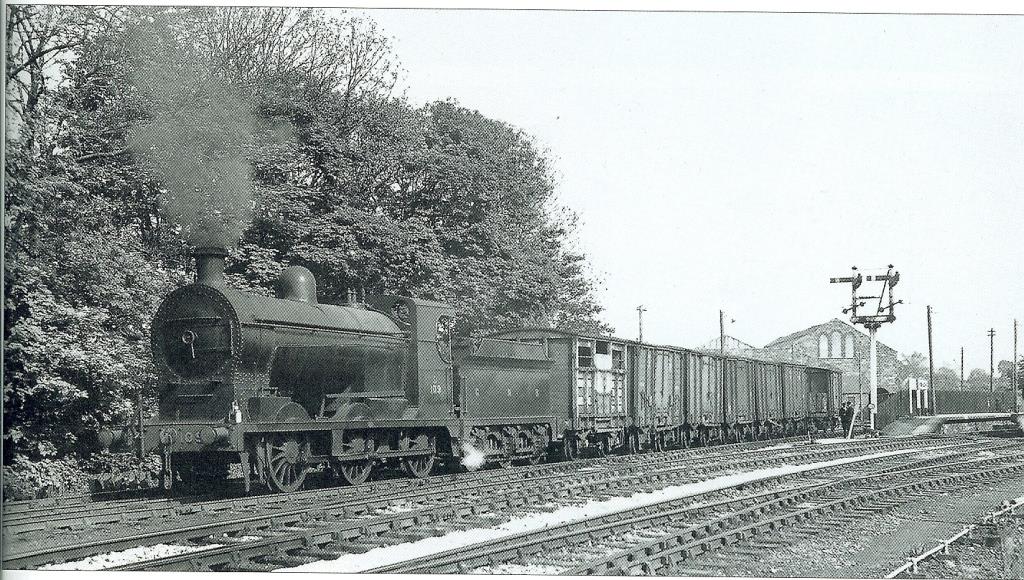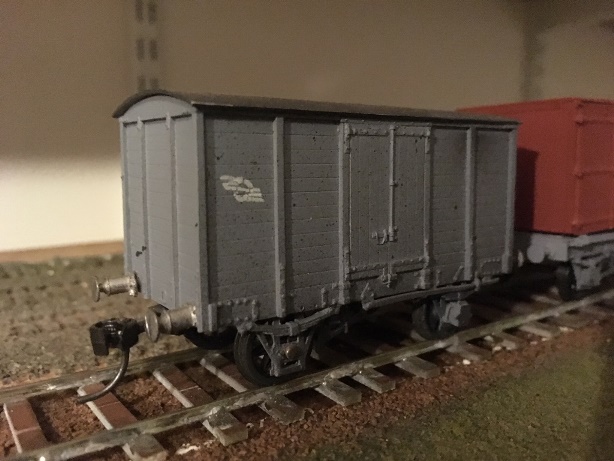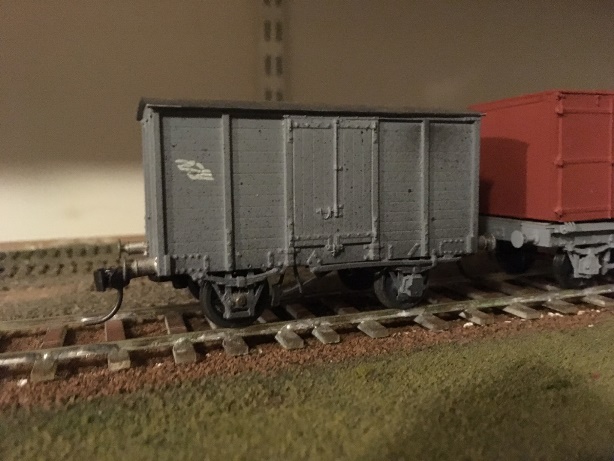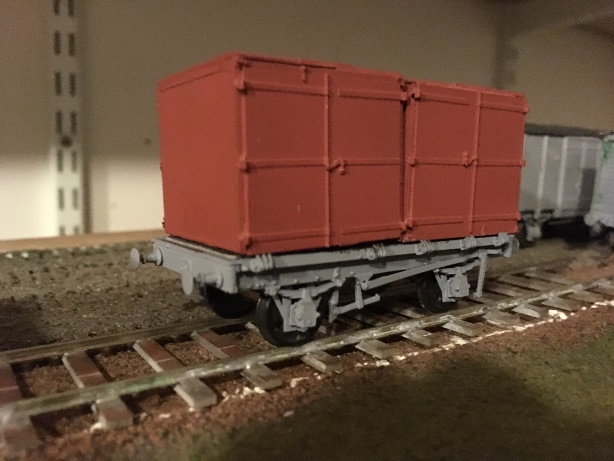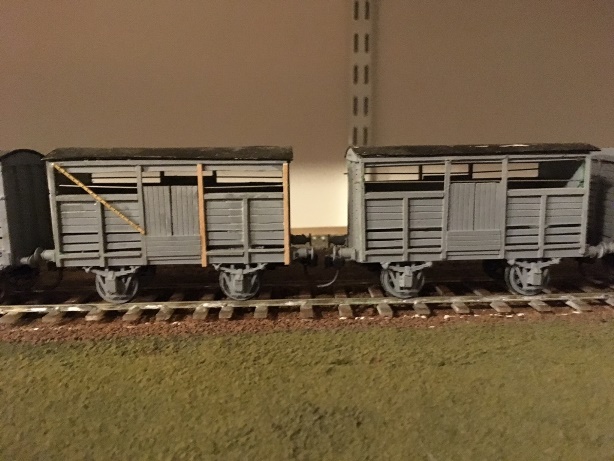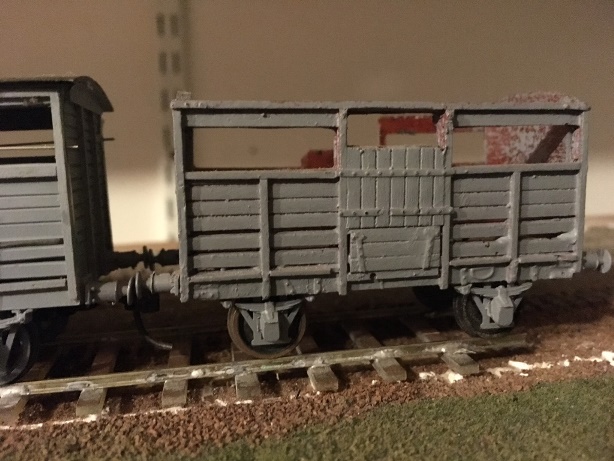-
Posts
4,855 -
Joined
-
Last visited
-
Days Won
119
Content Type
Profiles
Forums
Events
Gallery
Blogs
Store
Community Map
Everything posted by Mayner
-
Very nice Tony the goods shed and over-bridge nicely frame the layout like something out of one of an Iain Rice railway planning book.
-
It could be worse, I almost destroyed the body of a large scale diesel with paint stripper. I used one of the modern citrus based strippers to remove paint from the long hood of an American diesel was kit bashing into something else and managed to dissolve most of the detail from the doors. In our case the Rocky Horror Show analogy is particularly apt, Richard O'Brien lived in our house when his family lived in Hamilton during the 1960s
-

AutoCad Drawings to Laser Cut Plasticard
Mayner replied to GNRi1959's question in Questions & Answers
Cutting plasticard with a laser cutter is likely to release hydrochloric acid and chlorine gas both highly toxic and corrosive. https://www.eurolaser.com/en/materials/polyvinyl-chloride-pvc/ Metal or acrylic sheet would be a safer option. If you have a water jet cutter its just about capable of cutting anything. -
Basically means the railway could cram another 16 passengers into the coach when the armrests were raised. Interesting that the GNR was still building more expensive side corridor coaches more than 12 years after building the much cheaper to build K15 open stock
-
Interesting photo Dave looks like Drogheda before the centre road and sidings at the viaduct were removed the 121 on the MK3 threw me as I thought the sidings had gone in the 70s re-signalling The wagon is an interesting one of a small batch of rail carrying wagons built on redundant coach underframes in the early 80s. The cradle could be used for carrying steel slab or possibly point components
-
BR retrofitted the MK2 cars used with the Glasgow-Edinburgh push pull sets with heavy steel cow catchers similar to those used by CIE/IE on the Park Royal & MK3 push pull control cars. Some of the Irish MK3 push pull sets were used in Intercity services when the sets were displaced from Pearse-Drogheda services following the arrival of the 2700 Class railcars. Push-pull control cars used on Intercity services were retrofitted with standard MK 3 bogies with a max permitted speed of 90mph hauled and 70mph propelled. An 071 hauled set was used on the Sunday afternoon Longford-Connolly service, the train was hauled in both directions as the 141/181 & 071 class were not fitted with door controls. The construction of the MK3s was the end of an era in Ireland & the UK when government owned railways were expected to train engineering apprentices for private sector industry. All this changed in the 1990 with the shift to overseas manufacture and the railways focusing on running passenger trains & property development.
-
Omagh goods shed is what the Americans call a signature structure that immediately identifies the model as Omagh One thing that intrigues me is the disappearance of the high cathedral like gable end of the shed between Niel Spinks photo from 1954 & later photos. Omagh North 1954 LQG shunting morning goods from Enniskillen photo © Niel Spinks
-
Very impressive Kieran. How did you do the engines/gearboxes etc?
-
IE originally planned to build a fleet of MK3 diesel-electric railcars for use on suburban and secondary lines in addition to the 124 MK3 main line coaches currenty authorised. The MK3 push-pull sets were designed to replace the Park Royal coaches on Northern Suburban services and the MK3 main line fleet capped at 99? coaches when the Government refused to authorise the building of the railcars or additional coaches beyond the 5 Driving Cars. Interestingly the driving cars were designed to be retrofitted with a generator set and 3 phase traction motors hence the fitting of EMU bogies. IE had an acute loco shortage at the time, the 121s fitted with 645 engines from scrapped B201 class fitted the bill, though a 6 coach push pull set was pushing it. At the time (late 80s) IE may have hoped to get funding for additional railcars, the situation had changed by the early 90s when manufacturing jobs was less of an issue and Government procurement was opened up to meet EU requirements.
-
Not a bad model of CIE/GSR J8 444. A similar models of 444 and a 321 Class 4-4-0 both on Tri-ang chassis ran on the Malahide & Dromin Junction layout in the early 1970s. What other scratchbuilt locos have you in your treasure trove Dave?
-
The GSWR/GSR built similar 14' cattle wagons that lasted into the late 1950s the main spotting difference was the GSWR/GSR wagons had different end detail and nearly flat sheet steel or iron roofs. The final MGWR convertible wagons built after WW1 were a soft topped version of the Irish Standard covered wagon produced by Provincial wagons rather than the traditional 14' round roofed convertible wagon http://www.studio-scale-models.com/img/k14.jpg
-
Small scale live steam is completely unlike operating electric or battery powered models. The main draw back is that small scale models (anything below 7"1/2 gauge) are almost impossible to control and are too hot to handle while operating. Detailing of the 0-6-0 would have to be in metal & heat resistant paint otherwise you will end up with scorched paintwork and melted plastic. Even in LGB or Gauge1 live steam is difficult to control which is the main reason I have kept to battery RC and DCC control For the money involved a Gauge O or Gauge 1 Mamod https://www.mamod.co.uk/ or basic Roundhouse http://www.roundhouse-eng.com/models.htm#basic or Accucraft "Ruby" http://www.accucraft.com/modelc/AC77-010-C.htm would be a far safer investment than something on line from China. For modellers with deep pockets John Armstrong has produced custom models of a number of 3' gauge classes The garden railway suppliers in the UK will provide essential after sales service, but forget about anything looking like a scale model of an Irish standard gauge loco unless you have several thousand Eu to invest.
-
Pre-Manulla collision practice may have been to hold the home signal at danger to stop an approaching train, then lower the subsidiary signal to admit a train into a station, loop or siding in a similar manner to a "calling on arm" in the UK. I used NJ McAdams description of the subsidiary arms as calling on arms and later loop homes, Mc Adams appears to be an Athlone railway man who fired and later drove on the Mayo Rd from the 1940s. Two way signalling and reversible working at single line passing places appears to have been a GSR/CIE development following the singling of the Galway Line west of Clonsilla in the late 1920s and double line sections of the Mayo, Sligo & Meath Roads. The Manulla collision involved the Down Dublin-Westport railcar passenger and the C Class on the up Limited Mail. The railcar collided head on with the Mail on the Down Platform road. The signal man had not returned the subsidiary arm on the down home signal to danger or set the road for the passenger after the C Class completed a shunt on to her train. I wonder did the report make any comment on the risks created by permitting the Mail to shut into section while the passenger approached from Balla, the circumstances leading up to the 1979 Arklow collision are broadly similar a train running under apparently clear signals into an occupied section of track
-
The main question , anyone have any photos showing this mini-dolly signals ! elsewhere , thats shows the detail There is an explanation of Mayo Road signalling in N J McAdams 2 part paper on the Mayo Line in the IRRS Journal 1976 or 77 if I remember correctly. Briefly the mini-dollies were treated as calling-on signals up to the time of the Manulla Junction collision in 1961? then re-classified as "loop homes". I am not sure about Claremorris but the up platform was treated as the through road at a number of stations including Ballymoe, Castlerea & Castlebar . I have some Herbert Richard photos of the signals at Ballymore & can organise copies if you send me a PM
-
The loco looks closer to a LNER C13 Great Central K9 http://www.lner.info/locos/C/c13.php or possibly an ex-WLWR tank 4-4-2T https://transportsofdelight.smugmug.com/RAILWAYS/IRISH-RAILWAYS/CORAS-IOMPAIR-EIREANN-STEAM/i-DvHBvGf/A than a DSER or County Down loco. The GSWR rebuilt the WLWR locos with higher tanks which somewhat spoiled their appearance.
-
The MGWR & the GSR used BS11 90lb rail to re-lay the Dublin-Galway main line and the Mayo Road during the 1920. The branches were re-laid with 80-85lb rail cascaded from the main lines around the same time. The Sligo Line was re-laid around the same time with BS11 85lb rail. On the main lines rails were laid on cast iron soleplates cast to give a 1:20 cant to the railhead similar to bullhead chairs and screwed down with fangbolts. The BS 11 90Lb rail had a height of 5" 5/8 or 1.88mm”& foot width of 5 3/16” which scales out at 1.73mm which leaves the Code 75 fb rail reasonably close. The 85lb rail had the same foot width as the 90lb rail but marginally lower at 53/16”. Brassmasters http://www.brassmasters.co.uk/track_details.htm produce etched brass soleplates are based on a British military pattern quite different in appearance to the cast soleplates used in Ireland I have been planning to build a 21mm gauge model based on Kiltimagh the next station up the line from Claremorris for the best part of 20 years, intending to use Code 75 on the running lines and Code 60 in the sidings.
-
Shelton appears to have closed some time in 2002, I remember trying to chase the afternoon Ammonia train from Rathnew to the plant shortly before closure. Despite driving a reasonably high powered car the 201 hauled train won the race and was in the yard clear of the main line before I arrived in Shelton Interesting local take on the closure http://www.independent.ie/regionals/wicklowpeople/news/arklow-plant-punished-for-other-plants-inefficiencies-27820070.html, the plant was later dismantled and re-erected in India. Shelton was sending out bagged fertiliser by rail up to around 2001 when IE decided that the traffic was unprofitable the Ammonia traffic continued until the Marino Point plant closed.
-
It looks like a longer version of Diesel No1 Inchacore before they cleaned it up!
-
I think Cawoods imported coal through Belfast Port for destinations in the South which would have made rail a viable over road for line haul to Arklow. Does anyone know whether he traffic was for domestic or industrial use, its hard to imagine domestic users in Arklow & Wexford burning a 400 ton train load of coal a week during the winter months.
-
Triang L1 4-4-0 a good basis for anyone wanting to have a go at a D2 or other large 4-4-0 http://www.ebay.com/itm/Triang-Railways-R350-R36-Class-L1-4-4-0-Green-Livery-/332123972007?hash=item4d5421a1a7:g:X64AAOSwt5hYiRS- Triang-Hornby discontinued the model in the late 1960s and left a huge gap for anyone looking for a simple reliable chassis for a 4-4-0
-
Its stretching it a bit to describe cutting off the safety valves & whistle off the loco and painting it grey as a conversion from an M7 to 279. The big draw back to rtr conversions is that apart from the Woolwich, Jinty & LMS 2P 4-4-0 few British rtr locos look anything close to an Irish loco. The loco appears to be based on the original Triang-Hornby M7 from the late 60s owner probably would have been better to leave it in BR or SR livery. http://www.ebay.co.uk/sch/i.html?_odkw=triang-hornby+M7&_osacat=0&_from=R40&_trksid=p2045573.m570.l1313.TR2.TRC1.A0.H0.Xhornby+M7.TRS0&_nkw=hornby+M7&_sacat=0
-
If Carlsberg made whitemetal wagon kits ........"Geremy Suter Irish Kits" as short lived range of Irish wagon kits including the standard covered wagon, a GNR bread container wagon, a MGWR coal wagon and a GNR/UTA Bread van IRCH standard Irish covered wagon I bought a pair of these at Warley 17-18 years ago. The GNR(I), MGWR and some off the smaller railway companies bought/built similar wagons. I built this kit as an ex MGW wagon with large self contained buffers rather than the GNR style spindle buffers supplied with the kit. The wagon seems to have lost an axlebox cover somewhere along the way. . GNR Bread container wagon A bit out of place on a Southern layout the only one left and basically a very nice model.
-
Nice photo the loco shed looks like its lost half its roof at this stage. Do you recall if there a storm or tornado struck Omagh at some stage in the 1950s. Its odd the goods shed and the engine shed loosing their roof between 1954 and the early 1960s. Tony have you a better shot of the railcar set, it almost looks like a BUT 701 class car sandwitched between an L12 brake end coach (possibly as driving trailer) and a 6 wheel van
-
About 20 year ago I made a start on batch building a rake of KN (CIE long cattle) wagons & standard IRCH (Irish Railway Clearing House) standard covered van using plasticard & NE stripwood. I never finished the project Geremy Suter bought out an excellent whitemetal kit for the standard van & I started thinking in terms of a resin cast KN & IRCH open to avoid the repetitive stuff Scratch built KNs brake gear & strapping bolthead detail still to be added Prototype resin KN The master was prepared in basswood with etched brass overlays, the slatted construction lead to resin flowing into un-wanted places, and problems gluing the strapping to the basswood destroyed the appearance of the wagon. Still on the two do list, I will probably prepare a new plasticard master and custom design the strapping
-
Hi Rich I will send you a full size roof layout showing the positions of the vents.I basically remove the Dapol toilet plumbing mouldings and leave the strips. I found it easer to build these coaches with a removable body rather than a removable roof by gluing the roof to the body before cutting out for the window openings & floor. https://www.facebook.com/jmdesignmodelrailways. I ended up replacing the original donor body used in the original test build of the Buffet Car and re-using the overlays http://irishrailwaymodeller.com/showthread.php/2921-Tales-from-the-carriage-shops/page10
.png.c363cdf5c3fb7955cd92a55eb6dbbae0.png)

